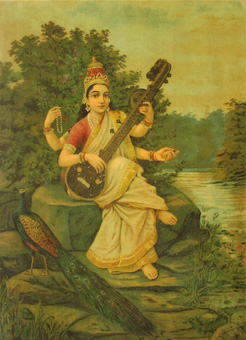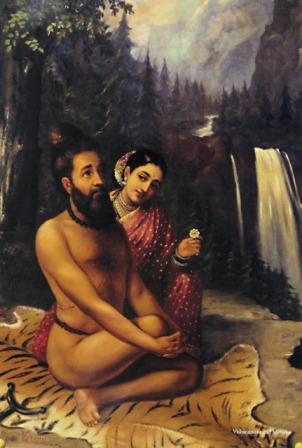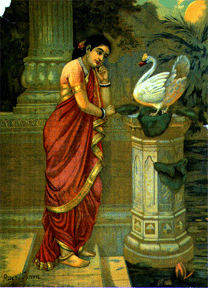Contribute
| South Asian Art - In Memory Of Prashant H. Fadia |
Ranjani Saigal
10/15/2008
“Moving from Trivandrum to Kilimanoor was quite a dramatic moment in my life. But for me the highlight everyday was a visit to the Kilimanoor Kottaram (palace) where Bhavani Tamburati (Princess Bhavani) would teach me to play Veena show me the studio that was used by Raja Ravi Verma. Often I would meet Mangala Bai Tamburati the sister of Raja Ravi Verma who at the age of 80 was a brilliant Veena artist and great painterâ€. I must have heard my mother say this a hundred times as she talked about the time her father decided to quit the urban life and move to this quiet village in the 1940s.
There must be something about this village for it produced one of the greatest painters of India. Raja Ravi Varma was born on April 29, 1848 at Kilimanoor. As a boy of five, he filled the walls of his house with pictures of animals and illustrations from everyday life. His uncle the artist Raja Raja Varma recognized his talents and gave him elementary art lessons. He was taken to Thiruvananthapuram in his fourteenth year to stay in the royal palace and learn oil painting. During these formative years the young Ravi Varma had many opportunities to discover and learn new techniques and media in the field of painting. His later years spent in Mysore, Baroda ad other parts of the country enabled him to sharpen and expand his skills and blossom into a mature and complete painter.
While he was certainly a “Raja†or a Prince by birth, I learned from my mother’s description of the life of the Kerala princes especially in Killimanore was fairly simple. It was not at all ostentatious by any stretch of the imagination. Their meals were simple made of roots and fruits available locally. But their generosity of heart was amazing as was their dedication to the arts. The major activity of the day was being tutored by a brilliant teacher "Madhavar" on music, practising Veena and painting. Ofcourse this was done not with any intention of stage performances but rather for the upliftment of the soul.
Raja Ravi Varma owed his success to a systematic training, first in the traditional art of Thanjavoor, and then in European art. His paintings can be broadly classified into 1.Portraits, 2.Portrait-based compositions, 3.Theatrical compositions based on myths and legends. Ravi Varma is considered as modern among traditionalists and a rationalist among moderns. He provided a vital link between the traditional Indian art and the contemporary between the Thanjavoor School and Western Academic realism. He brought Indian painting to the attention of the larger world.
Ravi Verma is an artist who is credited with bringing about a momentous turn in the art of India, influencing future generations of artists from different streams. He was the first artist to cast the Indian Gods and mythological characters in natural earthy surroundings using a European realism; a depiction adopted not only by the Indian “calendar-artâ€- spawning ubiquitous images of Gods and Goddesses, but also by literature and later by the Indian film industry- affecting their dress and form even today.
Learning to paint was not easy. The medium was very new and the technique equally elusive in those days. Only one person in Travancore knew the technique of oil painting - Ramaswamy Naicker of Madura, who, recognizing a potential rival in Varma, refused to teach him the know-how. Naicker's student, Arumugham Pillai would actually sneak into Moodath Madam at nightfall to share his knowledge with Varma, against his teacher’s wishes. Bhishma abdicating his right to the throne to get the fisher girl's hand for his father Shantanu
This clandestine education was only supplemented by watching a visiting Dutch portrait artist who painted the portraits of Ayilyam Thirunal and his wife. Through trial, error and hard work, Ravi Varma worked with the pliable medium, learning to blend, smooth and maneuver the flexibility that was afforded by this slow drying substance.
When Varma himself painted the portraits of this royal couple, this self-taught artist’s blazing talent far outshone the Dutchman! Ravi Varma’s creativity was further tampered by listening to the music of veterans, watching Kathakali, going through the manuscripts preserved in ancient families and listening to the artistic interpretations of the epics. He firmly believed in the hollistic approach to art, in the true Indian style.
Ravi Varma’s fame as a portrait artist soared with several important portrait commissions from the Indian aristocracy and British officials between 1870 and 1878, and the sensitivity and immense competence this artist still remains unsurpassed. His clever portrayal would add elegance to the personality of the protagonist, like unmasking the fragrance of a flower. The small town of Kilimanoor was compelled to open a post office, as letters with requests for paintings arrived from every where. The recognition that Ravi Varma received in major exhibitions abroad was for the portrait-based renditions, which were meticulous compositions of people, their demeanor and attires.
In 1873 he won the first prize at the Madras Painting Exhibition and he became a world famous Indian painter after winning in 1873 Vienna Exhibition. Though not really qualified for the title of a Raja, when an imperial citation happened to come across in the name of Raja Ravi Varma, the name stuck and stayed.
With oil paints applied thickly, Ravi Varma created lustrous, impasted jewellery, brocaded textures, and subtle shades of complexions. Though several folk and traditional art forms of India since time immemorial subsisted as illustrations for religious narratives, yet, illusionist paintings as a medium for story telling was Ravi Varma’s invention. He cleverly picked the particularly touching stories and moments from the Sanskrit classics.
Ravi Varma was convinced that mass reproduction of his paintings would initiate millions of Indians to real Art, and in 1894 he set up an oleography press called the Ravi Varma Pictures Depot. For photo-litho transfers, the Pictures Depot relied on Phalke's Engraving & Printing whose proprietor, Dhundiraj Govind Phalke, became famous as Dadasaheb of Indian Cinema a few years later.
While Raja Ravi Verma has long since left the world, his creations depicting stories and characters from another world has forever remained etched in our hearts.
You may also access this article through our web-site http://www.lokvani.com/

_l.jpg)

